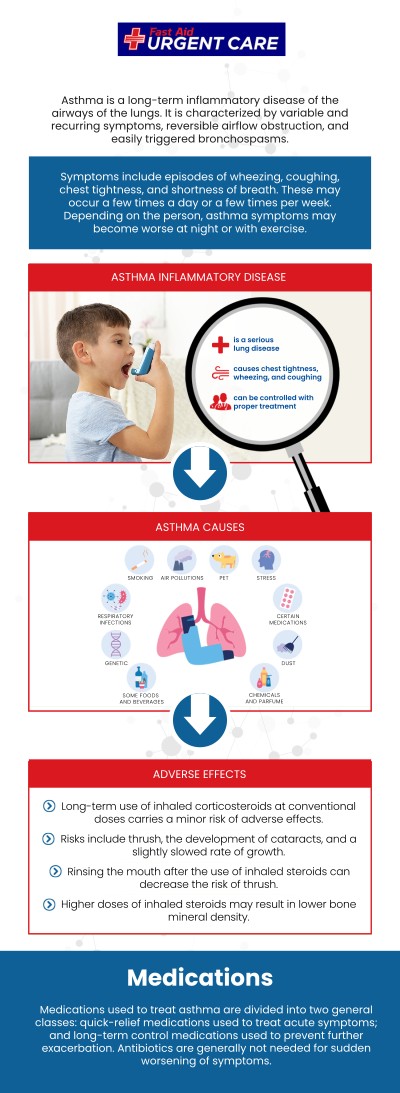Asthma Exacerbation in Children Q&A
At Fast Aid Urgent Care, our urgent care clinic provides excellent care, diagnosis, and treatment of pediatric asthma exacerbations. For more information, contact us or join the virtual line. We have convenient locations to serve you in Bulverde Rd San Antonio TX, Bastrop TX, Alamo Ranch San Antonio TX, La Grange TX, Leon Springs San Antonio TX, New Braunfels TX, Potranco Road San Antonio TX, Dripping Springs TX, Lemon Creek Boerne TX, and Belle Chasse LA.




Table of Contents:
What is asthma exacerbation in children?
What are the signs and symptoms of pediatric acute asthma exacerbations?
How is it diagnosed?
How is it treated?
Asthma exacerbations can be scary for children and parents alike to experience. However, the best thing to do in such a situation is to stay calm and seek swift medical attention. At Fast Aid Urgent Care, our pediatricians can provide quick, thorough, and excellent medical care for any child dealing with an asthma exacerbation.
Asthma exacerbation in children refers to episodes wherein a child experiences asthma symptoms that increasingly worsen over a definite period, caused by significant decreases in their respiratory and expiratory airflow. As such, asthma exacerbations can either occur acutely or sub acutely—that is, they can either develop rapidly within minutes or hours or gradually over several hours or days.
Asthma exacerbations in children range from mild or moderate to severe or life-threatening. As such, they also occur with a broad range of signs and symptoms, depending on the severity of the exacerbation. Some common signs and symptoms of pediatric acute asthma exacerbations include the following:
– Mild: shortness of breath (dyspnea) during physical activity, wheezing at the end of each exhaled breath, and intermittent coughing.
– Moderate: shortness of breath that restricts the child from participating in physical activity, wheezing during exhalation, increased heart rate (tachycardia), persistent cough, abdomen withdrawal inwards during inhalation and outwards during exhalation (paradoxical breathing), and accessory respiratory muscle retraction in the neck and between the ribs while breathing.
– Severe: shortness of breath while at rest that interferes with the conversation, muscle retraction in the neck and between the ribs while breathing, nasal flaring, wheezing during inhalation and exhalation, increased heart rate, persistent coughing, and withdrawn abdomen during inhalation.
– Life-threatening: shortness of breath that disrupts the child’s ability to speak or cough, sweating, exhaustion, grunting instead of wheezing, and increased heart rate or decreased heart rate (bradycardia).
Other symptoms of a pediatric acute asthma exacerbation could include abnormally fast breathing (tachypnea) or cyanosis, which is bluish discoloration of the skin and requires emergency treatment.
While the presence of any of the above symptoms can indicate an asthma exacerbation, they are more accurately diagnosed through spirometry, pulse oximetry, or peak expiratory flow (PEF) tests.
Spirometry and PEF tests assess lung function by measuring the amount of air the patient can inhale and exhale and the rate at which they do so. Patients are asked to inhale as much air and exhale as deep and long as possible into a mouthpiece connected to a machine that records the results. Mild asthma exacerbations typically have a peak expiratory flow rate (PEFR) of less than or equal to 70% of the patient’s predicted or personal best PEFR. The PEFR for moderate asthma exacerbations is between 40% and 69%. For severe asthma exacerbations, the PEFR is less than 40%, while the life-threatening PEFR is less than 25%.
Pulse oximetry tests measure the amount of oxygen saturation in your red blood cells. The pulse oximeter is attached to the fingertip, wherein it shines a light through the finger, enabling it to analyze the oxygen saturation percentage in the red blood cells. Mild asthma exacerbations typically have an oxygen saturation percentage (SaO2) of above 95% of their regular SaO2. The SaO2 levels for moderate asthma exacerbations are between 90% and 95%, while severe or life-threatening asthma exacerbations have SaO2 levels of less than 90%.
While mild asthma exacerbations can be treated at home with short-acting beta2-agonists (SABAs), asthma exacerbations that are moderate or more severe require medical attention at a pediatric clinic, urgent care clinic, or emergency department.
Moderate asthma exacerbations can also be treated using SABAs, which are bronchodilators that can help expand and relax the respiratory airway muscles to allow for easier breathing. SABAs can be administered through nebulizers, inhalers, tablets, or injections. Oral corticosteroids may also be provided depending on how well the patient responds to SABAs and their medical history.
Severe asthma exacerbations are typically treated in an emergency room, which typically involves partial relief using SABAs, in addition to oral corticosteroids and other adjunctive therapies.
Life-threatening asthma exacerbations must be treated at an emergency department, which will likely involve minimal relief using SABAs, in addition to intravenous (IV) corticosteroids and other adjunctive therapies.
If your child is dealing with an asthma exacerbation that is not life-threatening, we welcome you to come to see us for urgent care treatment. We serve patients from Bulverde Rd San Antonio TX, Windcrest TX, Selma TX, Bastrop TX, Paige TX, Smithville TX, Alamo Ranch San Antonio TX, Leon Valley TX, Helotes TX, La Grange TX, Rabbs Prairie TX, Halsted TX, Leon Springs TX, Fair Oaks Ranch TX, Cross Mountain TX, New Braunfels TX, Hunter TX, Zorn TX, Potranco Road San Antonio TX, Rio Medina TX, Rolling Oaks Estates TX, Dripping Springs, TX, Saddletree Ranch TX, Belterra TX, Lemon Creek Boerne TX, Scenic Oaks TX, Fair Oaks Ranch TX, Belle Chasse LA, Timberlane LA, Woodmere LA, and surrounding areas.

Additional Services You May Need
▸ Urgent Care
▸ Walk-in Family Care
▸ Children’s Health
▸ Sports Physicals
▸ DOT Physicals
▸ Pediatric Urgent Care
▸ Immunization

Additional Services You May Need
▸ Urgent Care
▸ Walk-in Family Care
▸ Children’s Health
▸ Sports Physicals
▸ DOT Physicals
▸ Pediatric Urgent Care
▸ Immunization





